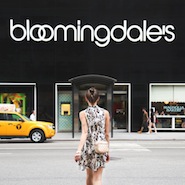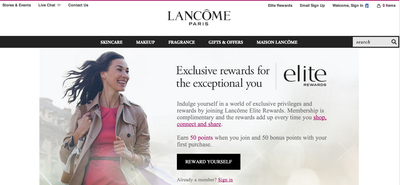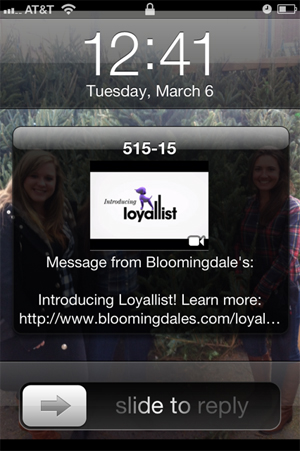 Image courtesy of Bloomingdale's
Image courtesy of Bloomingdale's
Sixty-two percent of retailers are planning to allocate more funds toward their loyalty programs this year, according to a new report from Boston Retail Partners.
Consumers are becoming more digitally driven, and loyalty programs have to change with them, incorporating mobile, gamification or consumer data to make the reward process more personal. Thinking of a loyalty program as another part of the omnichannel shopping experience enables a brand to reach consumers however they choose to interact.
“Loyalty programs are one of retailer’s best tools to know the customer, reach the customer and personalize the shopping experience,” said Ken Morris, principal at Boston Retail Partners, Boston.
“The 47 percent of retailers without a loyalty program are missing out on the opportunity to keep customers engaged, satisfied and loyal to the brand," he said. "They are also potentially losing customers to other retailers with loyalty programs, as one-third of consumers say they would not be loyal to a brand if it were not for a loyalty program.
"For most retailers, 80 percent of their sales come from the top 20 percent of their customers and it is imperative that you treat the loyal 20 percent with special rewards.”
Boston Retail Partners’ “Loyalty – Rewarding the Customer Experience” report uses data from its 2015 CRM/ Unified Commerce Benchmark Survey, which polled 500 U.S. retailers in March and April 2015.
Repeat customers
It costs a retailer anywhere from five to 10 times more to acquire a new customer than to retain an existing client, making it cost-effective to establish a program that incentivizes return visits, interactions and purchases.
Loyalty programs offer a way for retailers to both connect with their consumers in a meaningful way and get to know them better. The more a brand knows about a shopper’s personal preferences, the more effectively it can surprise and delight with rewards catered to them.
Forty-seven percent of those surveyed do not currently offer a loyalty program to their consumers, missing out on potential sales, as consumers tend to prefer to shop at a retailer that gives them something back for their business.
Boston Retail Partners references a 2015 survey of consumers by Bond Brand, which found that customers are enrolling in loyalty programs at higher levels than ever before. Seventy percent take loyalty programs into account when deciding where to shop as they look to get the most points possible.
 Lancome Elite Rewards
When asked about their top three priorities for this year, 46 percent of retailers mentioned a structured loyalty program. Only customer experience and engagement was mentioned more frequently, with 76 percent of respondents indicating it is a priority.
Retailers typically use data such as purchase totals, purchase frequency, online purchases and email subscription to determine rewards. These most often generate coupons or discounts, which are not always an effective purchase driver.
Effective loyalty programs go hand in hand with personalization. Knowing a consumer’s preferences can help ensure that rewards are actually valuable to that particular shopper.
Whether through smartphones, iBeacons or other technologies, retailers are ramping up their ability to pinpoint consumers and tailor shopping experiences, according to a previous report by Boston Retail Partners.
Ninety percent of retailers can identify consumers at the in-store check-out, up 17 percent from the year-ago period, but that is generally too late to make an impact, no matter how useful for profile-building and future engagement. In the next five years, there will be an 883 percent increase among retailers looking to identify consumers upon entering the store, according to the report (see story).
Lancome Elite Rewards
When asked about their top three priorities for this year, 46 percent of retailers mentioned a structured loyalty program. Only customer experience and engagement was mentioned more frequently, with 76 percent of respondents indicating it is a priority.
Retailers typically use data such as purchase totals, purchase frequency, online purchases and email subscription to determine rewards. These most often generate coupons or discounts, which are not always an effective purchase driver.
Effective loyalty programs go hand in hand with personalization. Knowing a consumer’s preferences can help ensure that rewards are actually valuable to that particular shopper.
Whether through smartphones, iBeacons or other technologies, retailers are ramping up their ability to pinpoint consumers and tailor shopping experiences, according to a previous report by Boston Retail Partners.
Ninety percent of retailers can identify consumers at the in-store check-out, up 17 percent from the year-ago period, but that is generally too late to make an impact, no matter how useful for profile-building and future engagement. In the next five years, there will be an 883 percent increase among retailers looking to identify consumers upon entering the store, according to the report (see story).
 SMS message from Bloomingdale's
Prompting consumers to opt-in via a loyalty program when they enter the store to receive personalized information such as their points accrued or their offers, gives retailers the opportunity to know who is shopping with them from an earlier stage in the purchase process.
Immersive interactions
Going beyond discounts can make a loyalty program more impactful, and make consumers more likely to participate. One tool retailers can use is gamification, which makes earning and getting rewards fun.
These game-like challenges could include liking items on Facebook or sharing purchases on Instagram to be recognized by the brand. Thirty-one percent of retailers are using gamification this year, a growth from 6 percent last year.
French perfumer Guerlain built exposure for its La Petite Robe Noire fragrance with a digital effort that combined consumer interaction and personalization.
Guerlain’s La Petite Robe Noire “Glamourometer” initiative was similar to a reward-based campaign where the consumer is rewarded as she interacts with the Web site. Interaction allows the consumer to feel that they are part of the brand’s lifestyle and will likely result in repeat visits, especially if a prize is offered (see story).
SMS message from Bloomingdale's
Prompting consumers to opt-in via a loyalty program when they enter the store to receive personalized information such as their points accrued or their offers, gives retailers the opportunity to know who is shopping with them from an earlier stage in the purchase process.
Immersive interactions
Going beyond discounts can make a loyalty program more impactful, and make consumers more likely to participate. One tool retailers can use is gamification, which makes earning and getting rewards fun.
These game-like challenges could include liking items on Facebook or sharing purchases on Instagram to be recognized by the brand. Thirty-one percent of retailers are using gamification this year, a growth from 6 percent last year.
French perfumer Guerlain built exposure for its La Petite Robe Noire fragrance with a digital effort that combined consumer interaction and personalization.
Guerlain’s La Petite Robe Noire “Glamourometer” initiative was similar to a reward-based campaign where the consumer is rewarded as she interacts with the Web site. Interaction allows the consumer to feel that they are part of the brand’s lifestyle and will likely result in repeat visits, especially if a prize is offered (see story).
 La Petite Robe Noir game
With consumers carrying phones with them everywhere they go, including into stores, it makes sense for a reward program to be mobile-optimized. There is an opportunity for growth, with 73 percent of retailers not offering a mobile option for their loyalty program.
Connecting with consumers via their mobile devices through an app or SMS enables a retailer to provide instantaneous alerts or coupons based on location, particularly at the point of sale.
Mobile accessibility also provides customers with an easy way to monitor their progress as they accrue points.
For instance, precision cut-crystal maker Swarovski is elevating the customer experience across channels with a new rewards mobile application.
Loyalty programs become effective when consumers use them frequently and for a range of purposes. Swarovski is ensuring regular use with “Sparkly” rewards or “Sparklisms” that can be earned for a variety of activities and exchanged for prizes (see story).
"Mobile devices and the opportunities they represent will have the greatest impact on the evolution of loyalty programs in the next few years," Mr. Morris said. “More than 50 percent of retailers are working to enhance their mobile capabilities for their loyalty programs in the next two years. Examples include tracking point balances, redeeming rewards, sending alerts to those customers near a reward threshold and offering special promotions.
"Another way that retailers are beginning to engage with their customers is through gamification," he said. "Engaging customers by utilizing game dynamics – gamification – helps stimulate brand engagement and foster long-term loyalty."
A loyalty program should be thought of as an integrated part of the omnichannel shopping experience, reaching consumers across channels.
"To operate a successful loyalty program requires a single centralized CRM platform to gather and maintain customer information across all channels,” Mr. Morris said. “This is prompting many retailers to implement a single commerce platform across all customer touch points that is tightly integrated to a centralized CRM system.
"Together, these represent a unified commerce platform, which facilitates high efficiency by combining CRM, traditional point of sale, mobile, Web, clienteling, order management and fulfillment into a consolidated, real-time platform," he said. "It also provides a single version of the truth across all channels to enable visibility and availability of customer information that can be used to support guided selling functions."
Final Take
Sarah Jones, staff reporter on Luxury Daily, New York
La Petite Robe Noir game
With consumers carrying phones with them everywhere they go, including into stores, it makes sense for a reward program to be mobile-optimized. There is an opportunity for growth, with 73 percent of retailers not offering a mobile option for their loyalty program.
Connecting with consumers via their mobile devices through an app or SMS enables a retailer to provide instantaneous alerts or coupons based on location, particularly at the point of sale.
Mobile accessibility also provides customers with an easy way to monitor their progress as they accrue points.
For instance, precision cut-crystal maker Swarovski is elevating the customer experience across channels with a new rewards mobile application.
Loyalty programs become effective when consumers use them frequently and for a range of purposes. Swarovski is ensuring regular use with “Sparkly” rewards or “Sparklisms” that can be earned for a variety of activities and exchanged for prizes (see story).
"Mobile devices and the opportunities they represent will have the greatest impact on the evolution of loyalty programs in the next few years," Mr. Morris said. “More than 50 percent of retailers are working to enhance their mobile capabilities for their loyalty programs in the next two years. Examples include tracking point balances, redeeming rewards, sending alerts to those customers near a reward threshold and offering special promotions.
"Another way that retailers are beginning to engage with their customers is through gamification," he said. "Engaging customers by utilizing game dynamics – gamification – helps stimulate brand engagement and foster long-term loyalty."
A loyalty program should be thought of as an integrated part of the omnichannel shopping experience, reaching consumers across channels.
"To operate a successful loyalty program requires a single centralized CRM platform to gather and maintain customer information across all channels,” Mr. Morris said. “This is prompting many retailers to implement a single commerce platform across all customer touch points that is tightly integrated to a centralized CRM system.
"Together, these represent a unified commerce platform, which facilitates high efficiency by combining CRM, traditional point of sale, mobile, Web, clienteling, order management and fulfillment into a consolidated, real-time platform," he said. "It also provides a single version of the truth across all channels to enable visibility and availability of customer information that can be used to support guided selling functions."
Final Take
Sarah Jones, staff reporter on Luxury Daily, New York
